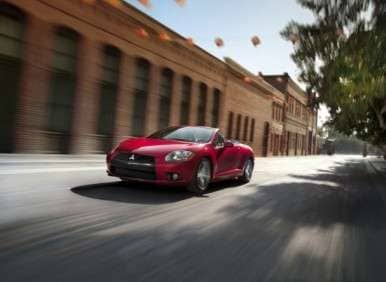Recent Articles
Popular Makes
Body Types
Mitsubishi Eclipse Spyder Used Car Buyer’s Guide
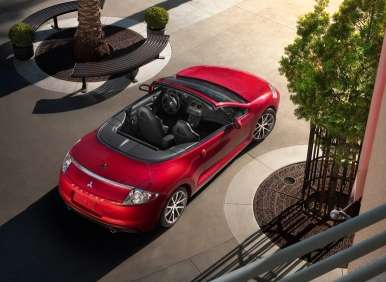
Named for an eighteenth century English racehorse, which in turn, was named for the celestial event, the Mitsubishi Eclipse was introduced in 1989. Its convertible version, the Mitsubishi Eclipse Spyder—the subject of this article—was introduced in 1996, as part of the second generation of the Eclipse, which was launched in 1995.
The term “Spider” as applied to automobiles, originated with the folding tops affixed to early horse drawn carriages. This occurred because the spindly spines of their folding mechanisms—in conjunction with the black cloth used for the top—resembled a spider.
The variation of the spelling (the usage of “Y” rather than “I”), originated with the Italians. The word, when spelled with a Y, is actually pronounced SPEED-aire, which is a derivation of the word “speedster”. While Spyder is commonly applied to cars with folding roofs, it doesn’t by necessity refer to one. Chevrolet, for example built a hardtop coupe model called the Monza Spyder back in the 1960’s.
In this case however, the word definitely means convertible. In fact, the Eclipse Spyder was designed specifically to be an open car. By doing so, Mitsubishi’s engineers avoided introducing the diminished structural rigidity generally imposed upon convertibles when they are adapted from a coupe body. It also avoided the totality of the usual weight gain necessitated by the additional bracing added to coupe conversions in an effort to reinforce the body structure after the top is removed. On average, the Eclipse Spyder was a mere 50 pounds heavier than its closed-roof sibling.
In total, there have been three generations of the Mitsubishi Eclipse Spyder offered as of this writing (April 2012).
Mitsubishi Eclipse Spyder Used Car Buyer’s Guide: 1996 – 1999
The original Mitsubishi Eclipse Spyder was offered in two versions, GS and GS-T. The front-drive convertible was available with a choice of two engines and two transmissions. The base engine, fitted to the GS, was a 141-horsepower inline four-cylinder. The “hot” engine was a 205-horsepower turbocharged inline four. Transmission choices were a four-speed automatic or a five-speed manual.
The power-operated folding top was insulated and featured a heated glass rear window. Like many convertibles, rearward visibility was compromised with the top deployed. This was exacerbated by the small size of the rear window. On the other hand, the four-seat Eclipse Spyder was a very solid piece.
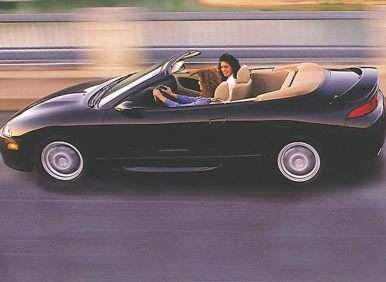
Mitsubishi Eclipse Spyder Used Car Buyer’s Guide: 1996
As stated before, the ’96 Eclipse Spyder GS used a 141-horsepower, 2.4-liter inline four-cylinder engine, which produced 148 ft-lbs of torque. The Spyder GS came equipped with cloth upholstered bucket seats, power brakes, a rear window defroster, tinted windows, fourteen-inch wheels, and a five-speed manual transmission; all as standard equipment. The Spyder also featured power steering, a remote trunk release, a tilt steering wheel, intermittent windshield wipers, power windows, power door locks, power mirrors and an AM/FM/Cassette-based audio system.
The options list contained A/C, a rear spoiler, cruise control, a CD changer, fog lights, keyless entry, ABS, a single disc CD player, a four-speed automatic transmission, leather upholstery, and an upgraded Infinity audio system.
The GS-T version of the 1996 Mitsubishi Eclipse Spyder used a 210-horsepower, 2.0-liter turbocharged inline four-cylinder engine. It too, featured a five-speed manual transmission as standard equipment. The Spyder GS-T feature-set contained all of the above as standard equipment; with the exception of the CD changer, ABS, and the automatic transmission; those were also options for the turbocharged model.
The cloth upholstery employed by the GS was replaced with leather for the GS-T. Leather was also used to trim the steering wheel and shift-knob of the GS-T. Sixteen-inch alloy wheels on the GS-T replaced the fourteen-inch wheels of the GS. And, the GS-T got an alarm system as standard equipment.
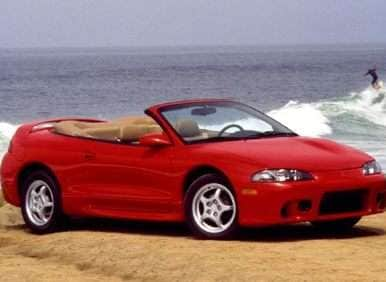
Mitsubishi Eclipse Spyder Used Car Buyer’s Guide: 1997/1998/1999
Going into the third year of production of the second generation of the Eclipse, the model got a mild styling update, which incorporated a new front and rear fascia treatment. Spyder got them too, even though it was only the second year of production for the open version of the car.
To accomplish this, the front grille opening was redrawn to appear more aggressive. Additionally, the headlights slanted more on the inner edges and used chrome reflector inserts rather than an all chrome fixture. The driving lights were sized down, thanks to the incorporation of a projection type instrument. At the back of the car, the rear bumper cap was altered. The reverse lights were restyled and moved away from the license plate.
Previously available only as options; A/C and a single-disc CD player were added to the GS standard equipment list. Chrome was applied to the wheels of the GS-T, to up the voltage of its appearance.
For the final year of production of the first generation of the Spyder, Mitsubishi’s product planners swapped the gauges in the GS-T out for a set with white faces and black script, replacing the black-faced gauges with white script. The 1999 Mitsubishi Eclipse GS drove into the sunset with black-faced instrumentation.

Mitsubishi Eclipse Spyder Used Car Buyer’s Guide: 2001 – 2005
Anybody tells you they can get you a super-hot deal on a 2000 Mitsubishi Eclipse Spyder is either a liar, or just plain don’t know what they’re talking about. There was no 2000 Eclipse Spyder. With the changeover to the third generation of the Eclipse for the 2000 model year, Mitsubishi delayed the reintroduction of the Spyder until the 2001 model year.
With the new model, the GS designation returned, but as the turbocharged engine was jettisoned in favor of a V6, the GS-T designation was scrapped. Replacing it was the GT nomenclature. Power output of the four-cylinder GS was increased to 147 horsepower, while the new V6 produced 200. As before, transmission choices were a five-speed manual and a four-speed automatic.
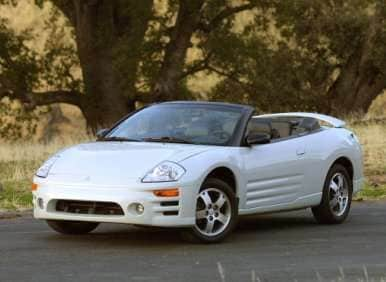
Mitsubishi Eclipse Spyder Used Car Buyer’s Guide: 2001
The 2001 Mitsubishi Eclipse Spyder GS used sixteen-inch alloy wheels and was powered by a 147-horsepower, 2.4-liter engine, producing 158 ft-lbs of torque.
The front-drive convertible featured a power-operated top and came standard with a five-speed manual transmission, a four speed automatic transmission was an option. Rather than a traditional automatic however, it was called Sportronic to reflect its sequential-shift capability. This permitted the driver to shift gears manually when desired. Ordering the automatic also got buyers the optional traction control, but ABS was not available for the Spyder GS at all.
The height adjustable driver’s seat featured manual lumbar support and, like the other three seats in the car, was upholstered in cloth. The Spyder GS came standard with remote power door locks, power mirrors and one-touch power windows. Cruise control, a rear window defogger, a front console with storage, front door pockets, and front cupholders were also included in the base price.
Other standard items included retained accessory power, speed sensitive power steering, 12v front power outlets, and a tilt adjustable steering wheel; in addition to A/C, reading lights, a leather wrapped steering wheel, front and rear floor mats, and vanity mirrors in the sun visors. The single-disc CD player fed a premium Infinity audio system consisting of seven speakers and a 210-watt amplifier. Safety gear included an engine immobilizer, fog lights, and electronic brakeforce distribution.
The Eclipse Spyder GT rolled on seventeen-inch wheels and was powered by a 200-horsepower, 3.0-liter V6, producing 205 ft-lbs of torque. It too, used a five-speed manual transmission as standard equipment, with the four-speed automatic as an optional choice.
All other GT equipment was identical to the GS.
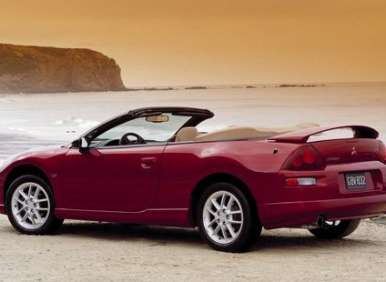
Mitsubishi Eclipse Spyder Used Car Buyer’s Guide: 2002/2003/2004/2005
The vanity mirrors got lighting.
A GTS trim joined the model lineup featuring a more powerful engine and amore plush interior treatment. All Eclipse models got a mild facelift, incorporating a sleeker front bumper and revised taillights.
To the equipment list of the GS and the GT, the 2003 Mitsubishi Eclipse Spyder GTS added a six-way power operated driver’s seat, leather upholstery, and audio controls on the steering wheel. It also got side airbags, disc brakes all around, and ABS was standard.
A seatbelt reminder was added.
The Remix Edition Package was offered for GS Spyder featuring a distinctive shift knob and steering wheel, in addition to leather upholstery for the front seating surfaces, there was a six-disc CD changer, plus sixteen-inch alloy wheels, a chromed exhaust tip, color-keyed door mirrors, an alloy fuel door, and a REMIX Edition badge

Mitsubishi Eclipse Spyder Used Car Buyer’s Guide: 2007 – 2011
If you’ve read this from the beginning, you’ve by now observed a pattern; whenever the Eclipse goes into a new generation, the convertible lags behind for a year. That said, with the introduction of the GEN4 Eclipse in 2006, the GEN3 Eclipse Spyder debuted in 2007. Thus, there was no 2006 Mitsubishi Eclipse Spyder.
When the model resurfaced for the ’07 model year, it was once again offered in two trim levels, GS and GT. The 2.4-liter engine previously powering the GS Eclipse Spyder returned, this time making 162-horsepower and 162 ft-lbs of torque. The GT got a 3.8-liter V6, making 260-horsepower and 258 ft-lbs of torque. Once again, the five-speed manual was the standard transmission for the GS, with the four-speed automatic available as an option. However, the 2007 Eclipse Spyder GT got a six-speed manual as its default transmission, and a five-speed Sportronic as its option.
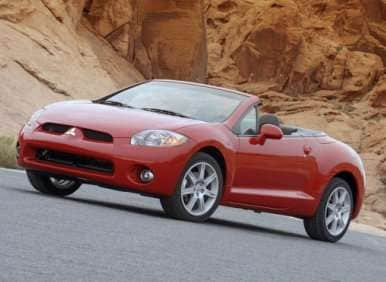
Mitsubishi Eclipse Spyder Used Car Buyer’s Guide: 2007
The 2007 Eclipse Spyder’s feature set consisted of seventeen-inch wheels, variable intermittent wipers, and a power-folding roof with a glass rear window and a rear defogger. The driver’s seat featured a manually adjustable lumbar support and like all the other seats, was upholstered in cloth.
Remotely operable power door locks, power mirrors and one-touch power windows were standard features too. Just as its predecessor, the 2007 Eclipse Spyder GS offered cruise control, a front console with storage, front cupholders, front door pockets, a remote trunk release, retained accessory power, speed proportional power steering, 12v front power outlets and a tilt adjustable steering wheel with audio and cruise control switches.
A/C, a cargo area light, front reading lights, leather trim on the shift knob and steering wheel, front floor mats and lighted vanity mirrors were installed as well.
The Rockford Fosgate audio system ran nine speakers, a subwoofer, a 650-watt amp, and a six-disc in-dash CD changer with MP3 playback capability. The audio system also benefitted from speed-sensitive volume control.
Options included a leather package, which bundled leather-trimmed and heated front seats with heated mirrors.
The safety suite was comprised of ABS at all four wheels, front side-mounted airbags, child seat anchors, an anti-theft alarm system, four disc brakes, daytime running lights, an engine immobilizer, fog lights, delayed auto-off headlights, a passenger sensitive airbag, electronic brakeforce distribution, and an inside emergency trunk release.
The GT was equipped identically—with the exception of a stiffer suspension system and the engine and transmission variations we described earlier. Also, the GT got traction control. The GT’s leather package also added eighteen-inch wheels, a wind deflector, and a power-operated driver’s seat.
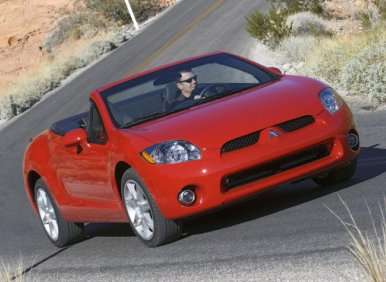
Mitsubishi Eclipse Spyder Used Car Buyer’s Guide: 2008/2009/2010/2011
For 2008, the Eclipse Spyder GT started using an eighteen-inch wheel as standard equipment.
The mid-cycle facelift reworked the front and rear fascias.The fog lights were revised and the triangle housing the "three diamond" logo was eliminated. The "Eclipse" insignia on the back of the car was changed from an indent to raised silver letters. An optional dual exhaust system and projector H.I.D. headlamps also became available. A revised exhaust system resulted in the power output of the V6 engine increasing to 265 horsepower and 262 ft-lbs of torque.
The manual transmission, an Eclipse Spyder mainstay since the model’s introduction, was eliminated. Bluetooth, satellite radio, stability control, and traction control became standard features. A rearview camera and auxiliary audio input jacks were introduced as well. The majority of the items from the options list were folded into the GT package as standard equipment. Thus, the 2010 Mitsubishi Eclipse Spyder came packed to the gills with eighteen-inch alloy wheels, larger rear brakes, Xenon headlamps, leather upholstery, heated side mirrors and front seats, a six-way power-adjustable driver’s seat, automatic climate control, a removable mesh wind deflector, aluminum scuff plates and pedals, an outside temperature display, and a compass.
The addition of heated leather seats and a power driver’s seat meant the GS was renamed GS Sport
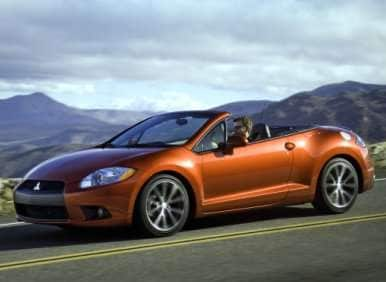
Mitsubishi Eclipse Spyder Used Car Buyer’s Guide: Current Model (2012)
For the final year, Mitsubishi’s product team outfitted the Eclipse Spyder equipment list as follows:
GS Sport ran a power convertible roof and rolled on eighteen-inch alloy wheels. The package featured variable intermittent wipers, A/C, keyless entry, cruise control, full power accessories, a tilt steering wheel, and a six-speaker CD sound system with an auxiliary audio input jack.
Xenon headlights, foglights, heated power mirrors, leather upholstery, heated front seats, a six-way power driver’s seat, Bluetooth, and a nine-speaker Rockford Fosgate sound system with a six-disc CD changer, satellite radio and steering wheel controls rounded out the list.
The SE model (new for 2012) came with all of the above, plus dark gray alloy wheels, matching rocker panel graphics and black mirrors.
Fold in the V6 engine, bigger rear brakes, a sport-tuned suspension system, and automatic climate control and you’ve got the 2012 Mitsubishi Eclipse Spyder GT.
